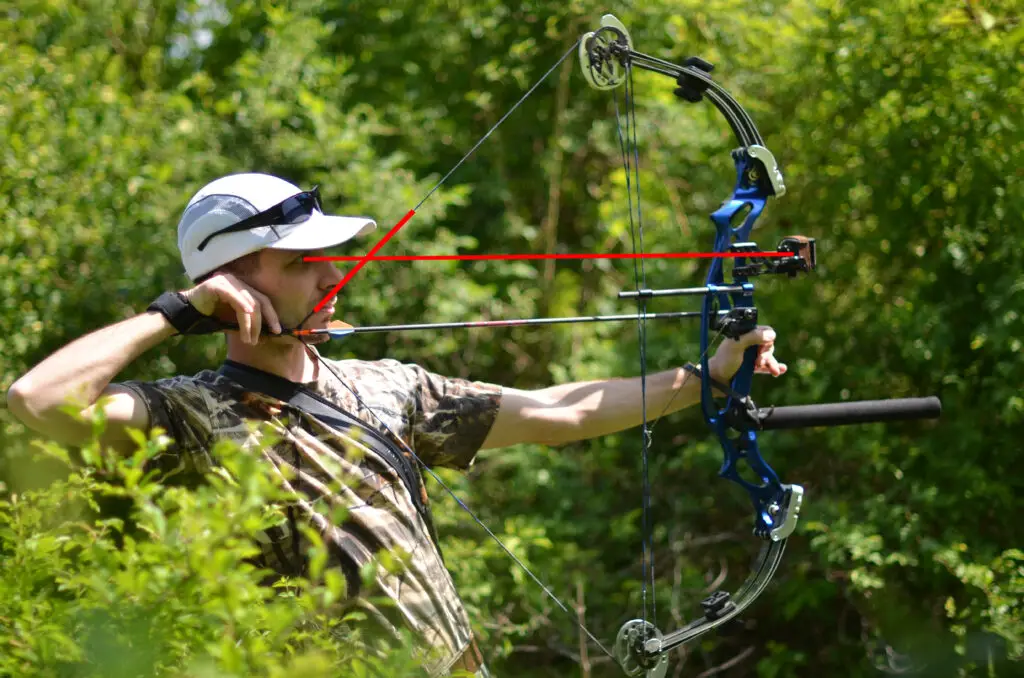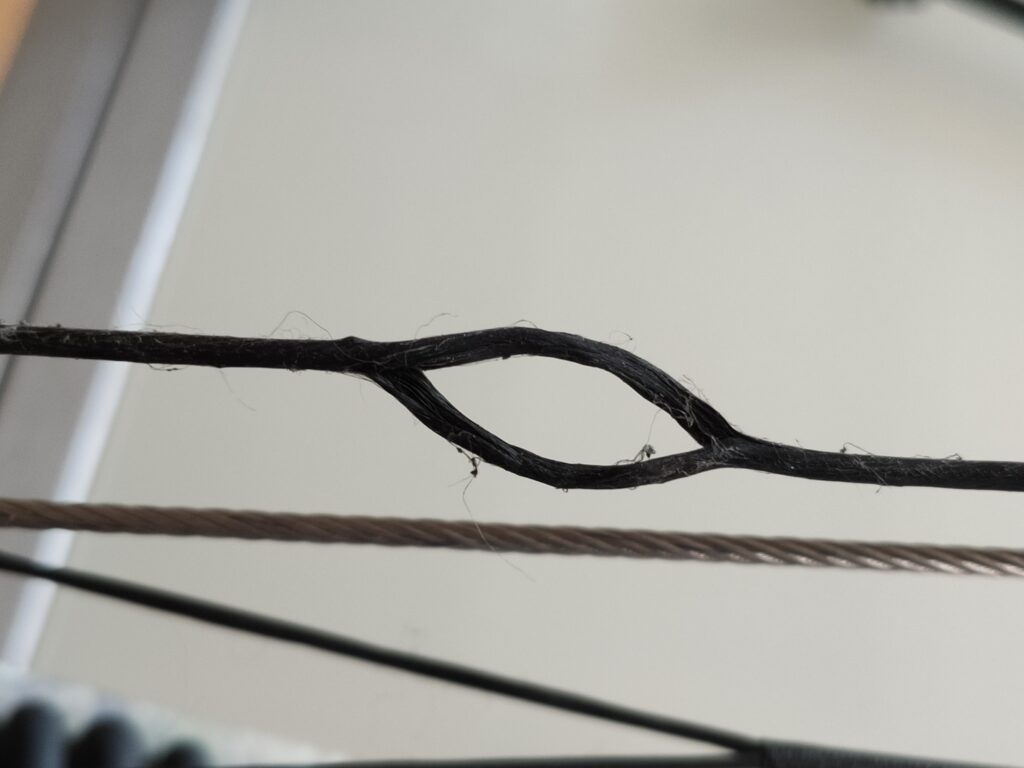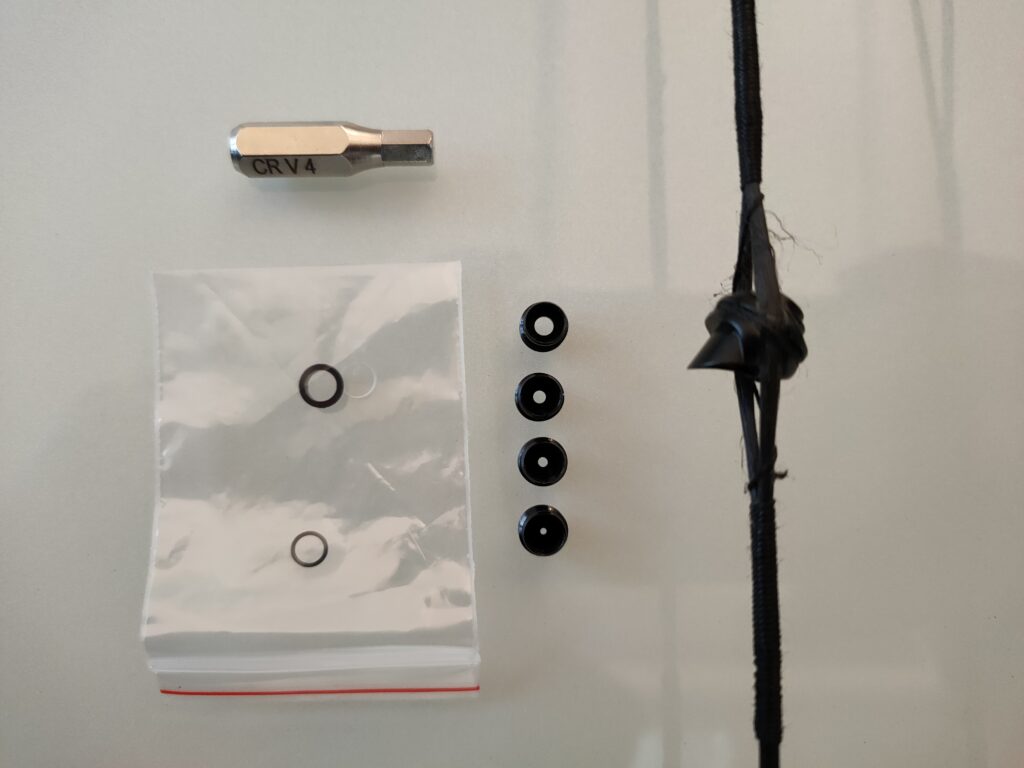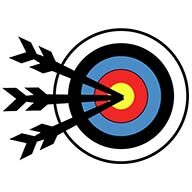I often recommend archers to set up and tune their own bow. The reason is that you will learn a lot during this process, and it is very useful to have these technical skills.
But setting up the peep sight is quite complicated. The problem is that you must get the peep sight between the fibers of your string, which is not possible without a bow press, on most compound bows.
In this article, I will give you a full guide on how to properly set up a peep sight!
Setting up the peep sight
To set your peep sight, follow the 5 steps below:
1. Determine the position of the peep sight
Before we start, we need to know where we want to have the peep sight. We need to be very precise as we cannot easily make changes, once we have tied the peep sight down.
To find the correct position of the peep sight, draw the bow and let someone mark the string where you look through the sight. There should be a straight line from your sight to your eye. The position where the line meets the string, is where the peep sight should be.
You can also do this on your own with a piece of tape. But it will take a few tries to get it just right. Make sure to check a few times if the mark is exactly in the correct position.

2. Release the pressure from the string
There are two methods to release the pressure of the string. The first method is by disassembling your bow. Beginner bows can often be disassembled by unscrewing the limb bolts. You basically follow these steps but in reverse.
Most advanced bows cannot be easily disassembled with the limb bolts. Also, if you are not sure this is possible, I wouldn’t try it because it can have extreme consequences when you do it wrong.
Luckily there is another good alternative. You can also release the pressure of the sting by using a bow press. This device presses on the limbs which releases the string. You can see how this is used in the video below:
The bow press used in the video can be purchased via this link.
3. Split the strands of the string
Once the pressure is released from the string, you need to split the strands of the string. Make a hole in the string by separating the strands. Make sure that you have the same number of strands on each side.
Once you have split the strands, you can place the peep sight in the hole you created. Pull on both sides of the string to close the hole, and the peep sight will stay put for the next step.

4. Tie the peep sight down
The next step is to tie the peep sight onto the string. Before you do that, make sure to remove the bow press. You need to check if the peep sight is in the correct orientation. If it’s twisted to the right or left, you should repeat the previous step again. Otherwise, you might have peep sight rotation issues. I will discuss how to solve that issue later, but it’s better to prevent it!
To tie the peep sight, you need to have some serving wire. This is some special yarn that helps protect your string. Here is the serving wire I use on my bows.
There are several techniques to tie down the peep sight. In my opinion, as long as it secures the peep sight, they are all fine. I have added a video below with the technique I use:
5. Test the peep sight
You might be tempted to test the peep sight before you tie it down, but that is not a good idea. Although it might seem quite sturdy even without the serving, there is a large chance that the peep sight slips loose during the shot.
When you attach the peep sight to a new bow/string, it is possible that you must adjust it later. The issue is that the string can still stretch a little. This can cause some peep sight rotation issues. Later in the article, I will discuss some solutions to fix that issue.
Adding an alignment tube
Some peep sights come with an alignment tube, that helps to align the peep sight. This essentially means that you will never have peep sight rotation issues. The tubing will pull the peep sight in the correct orientation. If you have a peep sight without an alignment tube, you can skip this section.
To add the alignment tube, follow these 5 steps:
1. Measure the ideal length of the tube: before we start, we need to know how long the tube should be. The easiest way to do this is to draw your bow and let someone measure the distance between the peep sight and the cable. Subtract 1 inch (3 cm) from this measurement and you have the ideal length of your tube.

2. Cut the tube to length: Use some scissors or an Exacto or Stanley knife to cut the tube to the measured length. Keep the tube longer if you aren’t sure about the length. You can always trim off the excess later.

3. Attach the tube to the cable: Most archers tie the new tube directly to the cable because that is the easiest. I like to tie mine with some serving wire because this allows me to adjust the tension without having to replace the entire tube. If you don’t have serving wire, I recommend buying this set. This set also includes a serving jig which allows you to replace the serving of your bow.

4. Attach the tube to the peep sight: To attach the tube to the peep sight you just must slide it over the fitting. This can be quite difficult because it’s a tight fit.

5. Test whether the tube stays put: In some cases, the tube might slip off the peep sight fitting. To solve this issue, you can use some serving wire to tie it down. Only use this trick, when necessary because it increases the stress on the tubing slightly.
Some additional tips:
- Make sure that the peep sight is already roughly aligned. The more the tube pulls on the peep sight the faster it will deteriorate.
- Don’t make the tube too short. This will cause the tube to stretch excessively at full draw which will severely limit the tube’s lifespan.
- Buy some spare tubing. The peep sight tubing will break eventually. It may last 1 or 2 years, but after a while, the material will deteriorate and break. I recently bought this peep sight tubing from Amazon, and I am very happy with the overall quality.
Peep sight with or without tubing – what is better?
There are some strong opinions in the archery community about both options. Some archers strongly dislike alignment tubes, while others wouldn’t shoot without it. The reason is that there are pros and cons for both options.
A tubeless peep sight is recommended for experienced archers who can work on their bow or frequently visit an archery shop. A peep sight with an alignment tube is recommended for new archers who don’t want to bother with peep rotation issues and are looking for the easiest solution.
There is no real right or wrong, but only preference. I can tell you that the issues you can experience with both solutions are rather annoying. When the peep sight tubing breaks, you must replace it. Also, when the peep sight is misaligned, you must make changes. So, you must balance between the two evils.
In the article below I have a full analysis of both options. I also explain how both options affect the dynamics of the bow.
Tube vs tubeless peep sight – what is better
Q&A
Peep sights seem like extremely simple devices. It’s just a small piece of metal or plastic that allows you to look through the string. Although that is true, there is a lot to consider when buying and setting up a peep sight. Below I answer some of the most frequent questions I get.
What is the best peep sight?
As mentioned earlier, you first need to choose whether you want a peep sight with or without tubing. Below are my recommendations based on your choice:
Peep sight with tubing
A lot of peep sights with tubing have a fitting that can easily damage the tube. These fittings have sharp edges, which are supposed to grip the tube. In my experience, this design can cause the tube to tear after a lot of use.
Although I currently don’t shoot with a peep sight tube anymore, many of my friends use the Pine Ridge Archery Nitro Peep Sight. Since this peep sight has a smooth tube fitting, it doesn’t strain the tube that much.
Also, silicone tubing tends to last a lot longer than rubber tubing as you can read from this article.
Peep sight without alignment tubing
Since most experienced archers shoot with a peep sight without alignment tubing, there are a lot of great options on the market. I recently bought this generic brand peep sight and overall, I am very happy with its performance.

The sight housing is made of aluminum and is therefore more durable than plastic. Some other features I like are:
- Adjustable pinhole size
- Included clarifier (which allows you to shoot with higher magnification)
- Sunhood on top of the sigh pin
Overall, you just get a lot of flexibility in one package, so I highly recommend it!
The peep sight rotates when I draw the bow, how to fix it?
When your peep sight rotates during the draw it will lose its function as you cannot look through it anymore. To fix peep sight rotation issues you can use any of the following tips:
- Use an alignment tube: some peep sights allow you to add an alignment tube. If this is possible, it’s a very easy fix. Just follow the guide above to add the alignment tube.
- Train your peep sight: if your peep sight only rotates a little (less than a quarter turn), you can often train it to stay in the correct orientation. Just turn it into the correct position or a bit further if it’s stubborn. You will have to do this for quite a while, but after a while it will stay in the correct orientation.
- Remove and re-attach the peep sight: when it’s not possible to train the peep sight, the best option is to remove and re-attach the peep sight. Although it is quite an ordeal, it is the best way to solve the issue.
My peep sight tubing broke or came loose, how to fix it?
When your peep sight tubing breaks, you will need to replace the peep sight tubing. In some cases, you can reuse the old tubing in a pinch. But the only long-term solution is to replace the peep sight tubing. Make sure to purchase some silicone tubing as it’s more durable than natural rubber.
If your peep sight tubing keeps slipping of the fitting, this could indicate that the tube is too short. There is too much force on the tube which causes it to slip off the fitting.
If you are experiencing these issues, I highly recommend reading my detailed article below. I give tips for all kinds of situations and give you a detailed guide on what you should do.
Peep sight tubing breaks or slips off – how to fix it
Do you need a peep sight?
You may find some compound archers that are not using a peep sight. So, you might wonder whether it’s necessary to use peep sight. Olympic recurve archers are also shooting without a peep sight, and they are very accurate.
It is not strictly necessary for a compound archer to use a peep sight. The peep sight is simply a tool that allows you to see the target clearer and it helps you align the bow. Although it’s not necessary, it is highly recommended.
Why not use all the tools you have available to improve your accuracy? Although setting up the peep sight can be a pain, it also helps you to be more accurate and shoot more relaxed. Also, by using a peep sight, you can always use a clarifier which can help you to shoot with a higher magnification sight.
More about the peep sights
I have written a lot of articles about peep sights. If you want to deepen your archery knowledge, click on any of the articles below:
- 5 best peep sights
- Tube vs tubeless peep sights
- Peep sight tube broke or slips off – how to fix it
- 6 tips to fix peep sight rotation issues
Final words
I hope this article was helpful and provided you will all the necessary steps to set your peep sight. If you have any questions, or suggestions, please feel free to leave them down below. I will reply as soon as possible!
Tim van Rooijen
For as long as I can remember, I have always been fascinated by archery. First due to its historic significance but later because I like being outdoors. With this blog, I share my knowledge about Archery and how you can improve your shot. More about author…



